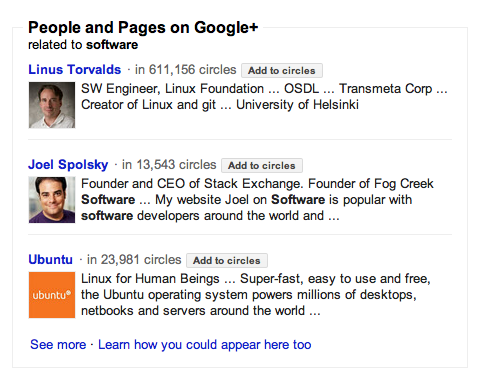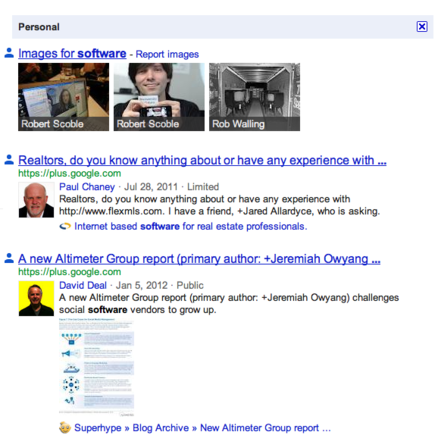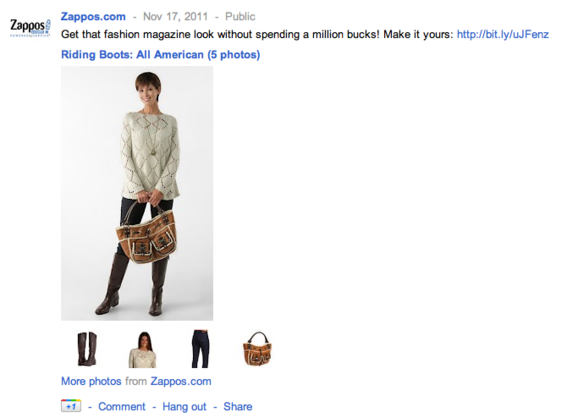We all expected Google+ would factor into Google’s search results. Now we know how.
Google recently announced in its blog the integration of its new social network into search by including results from the searcher’s Google+ friends and interests. This only works for searchers who are logged into Google via a registered account — Gmail, for example — and who have a Google+ profile. Called “Search plus Your World,” here’s how the new feature works.
When I search for “software,” two new elements now appear.
First, there’s now a section on the search returns page in the right-hand column called “People and Pages on Google+” — results related to my keyword search.

People and Pages is a new element added to Google search results.
Second, at the top of the results page I now see this.

When I click the “80 personal results” link, it opens a page showing keyword-related results from people in my Circles.

Also, notice from the screenshot above that images are included as part of the personal results. They, too, are from Google+ users.
According to the Google announcement, three features are built in.
- Personal Results enable searchers to find information personalized just for them, such as Google+ photos and posts.
- Profiles in Search enable searchers to find people they are close to or might be interested in following.
- People and Pages help searchers find Google+ profiles and business pages related to a specific topic or area of interest.
Impact of Including Google+ in Search Results
So much for how it works. Why is it significant?
- It makes search more personal. Search engines do a decent job of finding relevant web pages and other types of content. That’s their primary function. Adding personal results from friends changes that dynamic. Searchers will likely be interested in what their friends are sharing versus the impersonal returns that search engines have traditionally provided.This could mean an immediate payoff for Google in two ways: time spent on search is likely to increase and, for some, Google search may become more of a destination rather than a tool.
- It simplifies search. Google Search and Google+ are now merged. It’s more convenient.”Search is pretty amazing at finding that one needle in a haystack of billions of webpages, images, videos, news and much more,” says the Google blog post. “But clearly, that isn’t enough. You should also be able to find your own stuff on the web, the people you know and things they’ve shared with you, as well as the people you don’t know but might want to… all from one search box.”
What This Means for Merchants
In my view, this makes the use of Google+ almost a necessity, for two reasons.
- Recommendations. Consumers trust personal recommendations, especially from friends. By maintaining an active presence in Google+, merchants leverage that trust factor.
- Helps with search engine optimization. It could improve the chances of a merchant’s site getting found via search. Let’s face it, achieving first page returns in organic search is not always easy. An entire industry has been built around that goal. And while there is no guarantee a merchant’s content will be included in the searcher’s personal results, at least it helps.
3 Steps for Merchants
- If you don’t already have a Google+ business page, set one up. My previous article on the topic, “How to Create a Google+ Business Page,” should help.
- Share content with Google+ regularly. Zappos’ Google+ page is a good model to follow. The company shares product images with links to the online catalog, videos, status updates, news about issues related to the company, and even personal anecdotes.

- Build your network. It does no good to post content if you don’t have a group of followers to share it with. One way to do this is by adding a Google+ badge to your website that links to your Google+ page. In addition, add the +1 button to product pages, which enables people to recommend your products and services. Once people add your page to their Circles, add them back.
Conclusion
Google apparently couldn’t agree with Facebook on including its content into search, unlike Bing. The Google Realtime experiment, which streamed Twitter results, didn’t pan out — here’s a Search Engine Journal article that explains. So Google built Google+ and incorporated that content into search.




